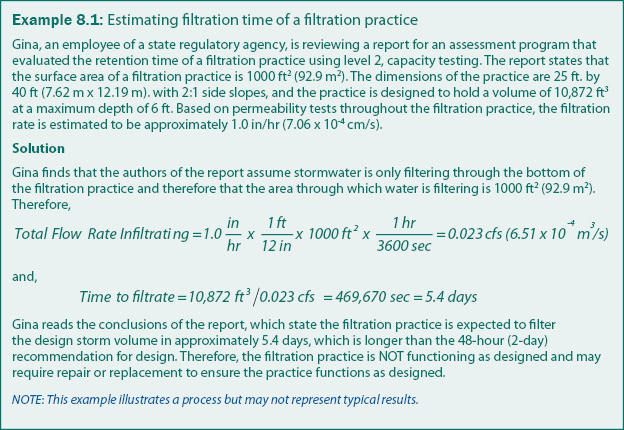
Capacity Testing Filtration Practices
A.J. Erickson, J.S. Gulliver, R.M. Hozalski, P.T. Weiss
Capacity testing (level 2) for filtration practices involves a series of hydraulic conductivity point measurements. These conductivity tests are used to estimate the filtration rate, which can subsequently be used to estimate the amount of time the design storm would require to drain. After the overall average filtration rate is estimated from the point filtration rate measurements, the design storm volume (m3, ft3, etc.) can be divided by the filtration rate (m3/day, ft3/day, etc.) to determine the amount of time required to drain the design storm volume (hours, days, etc.). See example 8.1.

Hydraulic conductivity tests can also be used to detect the presence of macropores within a filtration practice. Sand filtration design recommends a saturated hydraulic conductivity (k) of 3.5 ft/day (1.07 m/day) (Claytor and Schueler 1996, Minnesota Stormwater Manual). If the results from the hydraulic conductivity tests indicate that the median hydraulic conductivity for the entire practice is larger than 280 ft/day (85.34 m/day), macropores may be reducing the sieving process and thus reducing solids removal efficiency. Additionally, if an area of the filtration practice has a hydraulic conductivity greater than 280 ft/day, macropores may be significantly reducing the sieving efficiency of that area. Filtration rates less than 280 ft/day do not preclude the presence of macropores, but indicate that the amount of macropores is not necessarily significant.
Hydraulic conductivity tests are applicable to surface, underground, and hybrid filtration practices. Hydraulic conductivity tests in hybrid filtration practices, however, should be interpreted differently from conductivity tests as applied to surface or underground filtration practices. In the locations that the hybrid filtration practice filters water (sand or soil filtration media, subsurface collection system), hydraulic conductivity tests indicate the rate at which stormwater runoff is filtered. In areas of stormwater storage, infiltration, or both, hydraulic conductivity tests indicate the rate at which stormwater runoff infiltrates into the surrounding soils and therefore the rate at which stormwater runoff volume is reduced by infiltration. The spatial summation of these two components, filtration rate and infiltration rate, is the rate at which stormwater runoff is treated by the stormwater treatment practice and this value should be used to determine the drain time for the hybrid filtration practice. If the hybrid filtration practice is not capable of draining the design storm in less than 48 hours, maintenance may be required to increase the filtration rate, or the practice may need to be redesigned to increase the area that is used for filtration.
Continue to Synthetic Runoff Testing.